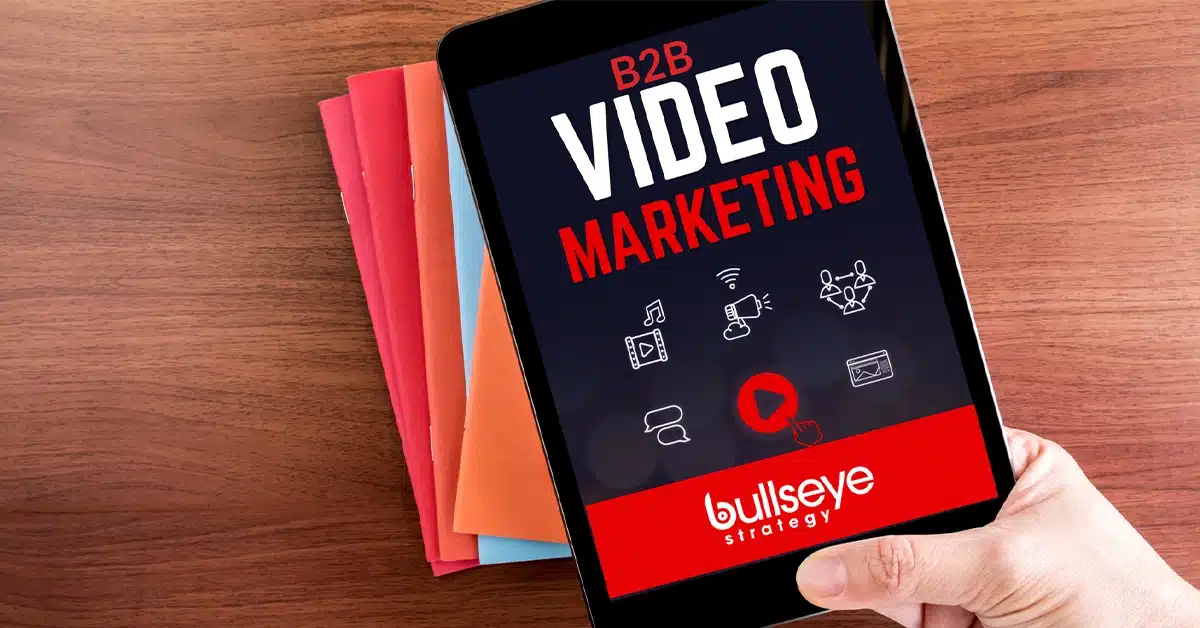The digital landscape is ripe with channels for B2B video marketing. Ranging from social media sites like Facebook, Instagram, and TikTok to traditional YouTube videos, video podcasts, and webinars. Right now, a massive 86% of all businesses utilize video as a marketing tool, and 71% of B2B companies report video as a critical part of their content strategy. Emerging trends all suggest B2B video marketing is the future—and the future starts right now.
The growth of B2B marketing videos has exploded and will continue to dominate marketing channels for years to come. Recent studies indicate that 95% of video marketers intend to increase or maintain their video budget year over year, and a whopping 88% of businesses are reporting a positive return on the investment (ROI) from video. B2B marketers who are hesitant to invest in video marketing are quickly falling behind the times.
In this post, we dive deep into the rise of B2B video marketing, why it’s a sound marketing strategy, and how to craft a holistic B2B video marketing campaign that converts.

The Consistent Rise of B2B Video Marketing
Just three years ago, the State of Video Marketing 2018 report discovered that prospects watched an average of 1.5 hours of online video per day. Fast-forward one pandemic and countless hours at home later, and that amount of time has skyrocketed. 68% of consumers report the pandemic has impacted the amount of video content they consume daily, with 96% agreeing that the amount has increased. The overwhelming majority of B2B customers, including B2B buyers, consume more video content now than ever before.
Due to the growth in popularity of social media platforms like TikTok, Instagram Reels and Stories, and Triller, video has become an increasingly effective marketing channel. YouTube and Facebook, long-time contenders in video, continue to reign supreme among video marketers’ platforms, utilized by 89% and 70%, respectively. However, the rise of B2B video marketing has now eclipsed the native video format to now include explainer videos and webinars placed on landing pages and product descriptions.
Explainer videos or product demos, in particular, have become paramount in the decision-making process, from brand awareness to sales qualification and conversation. An incredible 94% of people cite watching explainer videos as their method to learn more about a product. An overwhelming majority of buyers also agree video has swayed their decision to make a purchase, with eight out of ten reporting they’ve been convinced to purchase an app or piece of software directly through video marketing.
As video content solidifies its position within a strong content marketing strategy, now is the time to learn why B2B video marketing is a necessity, not an option.
Why B2B Video Marketing is a Necessity, Not an Option
If you haven’t jumped on the B2B video marketing bandwagon yet, the following video marketing statistics might help you get on board:
- Users are 27.4 times more likely to click on a video ad than a static banner ad.
- 80% of video viewers recall the video advertisement they watched.
- 46% of those viewers take action as a response to the video’s message.
- Brand consideration can rise to 61% if the viewer enjoys the content.
Even more, the vast majority of B2B marketers agree that video outperforms alternative content for producing conversions. 88% of marketers report that video marketing supplies their business with a positive return on investment (ROI), a percentage that’s skyrocketed from just 33% in 2015. As far as lead generation goes, online videos are 600% more effective than print and direct mail advertising combined.
Considering the typical buying group for a complex B2B solution can involve six to 10 decision-makers, video marketing is essential throughout the entire marketing funnel to generate leads and drive conversions. In addition to raising brand awareness, video content can also take the form of educational webinars, customer testimonials, and case studies that help buyers along their decision-making process.

How to Craft B2B Video Marketing Campaigns that Convert
B2B video marketing is a vital element of a successful B2B content marketing strategy. B2B marketing videos harness audio and visual components to directly sell a product or service to a corporation, distributor, retailer, or manufacturer. Unlike business-to-consumer (B2C) video marketing, which often focuses on emotion-driven purchase decisions, B2B video marketing features a high degree of specificity that drills down into the benefits and financial aspects of a product or service.
If you want to craft a high-performing B2B video marketing campaign, there are several steps you’ll need to consider:
- Understand what you offer and your core competencies
- Clearly define your campaign budget
- Outline your campaign goals
- Establish who you’re targeting with each video
- Solidify messaging and have a production plan
- Publish and promote your videos
- Track your B2B video marketing efforts
Let’s discuss each step’s intricacies and how they influence a holistic B2B marketing strategy.
1. Understand What You Offer & Core Competencies
By now, you probably have a well-defined target audience. You’re well-versed in their pain points, content preferences, and the style of messaging that resonates best. You’re also well aware that most B2B buyers consist of multiple players, not just one individual. To receive buy-in from the entire group, you’ll need to display solid use cases and benefits that each individual can identify.
To receive group-wide buy-in, it’s paramount to understand what you offer to buyers properly. It’s not enough to simply know the types of products or services you offer. Instead, you need to fully understand the pain points these products or services solve and how they relate to your target audience. Only once you nail down what you offer and your core competencies can you begin to create content that converts.
Knowing what you offer and your core competencies can be critical as you plan your video strategy, create the videos themselves, add calls-to-action (CTAs), and define your campaign goals.
2. Clearly Define Your Campaign Budget
Your budget will set the tone for the possibilities—or limitations—of your video marketing campaign. While your budget won’t need to be astronomical, you must have some funds allocated to video production. Otherwise, it’s not worth moving along with the process.
Quality matters for B2B buyers. Unfortunately, a lack of budget (even a meager one) will often equate to a lack of video quality. To calculate a rough estimate for your B2B video marketing, consider the time and cost of video production. Will you create the videos in-house or outsource them to a vendor?
If you choose to produce video marketing in-house, factor in the cost of specialized equipment, editing software, and company human resources. If you decide to hire a professional video company, factor in the price of videographers, scriptwriters, and location and travel costs. You can even outsource video production to a full-service digital marketing agency, which can film, edit, and distribute your content for you.
Once you set your budget in stone, you can outline clear campaign goals.
3. Outline Campaign Goals
To create a video marketing campaign that converts, you must establish tangible goals. Without goals, how will you measure success? Effective B2B video marketing campaigns should outline a clear purpose, which will ultimately influence the content and style of the finished videos and the overall marketing strategy.
To set achievable campaign goals, consider what you’re trying to accomplish:
- Improve audience retention rate
- Enhance engagement on social platforms
- Increase overall lead generation and conversions
- Reach clients at different points in the B2B sales cycle
- Inform customers how to use a specific product or service
- Support organic and paid media marketing efforts
With your goals in mind, you can then establish who you’re targeting with each video.
4. Establish Who You’re Targeting with Each Video
Even with a robust understanding of your target audience, it’s imperative to establish the type of B2B buyer you’re targeting and at which stage of the sales funnel. Have they heard of your company before or been on your website? Have they used one of your services but not another? You must understand the fundamentals of sales funnels and craft campaigns around where people are within them.
Each sales funnel starts with awareness and discovery. You cannot produce a video pitching a very complex service you offer without first educating people on your company and what you generally do. So, if you’re targeting those at the top of the sales funnel, consider creating a brand video to familiarize target buyers with your business. Tutorial videos can also help to introduce your product or services to buyers at the top of the funnel.
On the other hand, B2B buyers in the evaluation or deciding phase of the sales funnel are already familiar with your company or services. However, they need a bit of motivation to seal the deal. In this case, a case study video or testimonial video can serve as an invaluable asset to illustrate your product or service’s real-life benefits.
5. Solidify Messaging and Have a Production Plan
Now that you have taken the time to understand your offerings, set your budget and goals, and separate prospects by their position in the sales funnel, the next step is to create your videos. With all of the above in mind, brainstorm your messaging first.
Are you looking to inform or entertain? Do you want to introduce your brand or explain how a certain product functions? Tap into the style guide used for the rest of your current marketing: Are your style and tone authoritative or friendly? Use these factors as a basis for your messaging. Then, consider the structure of your video.
The majority of successful B2B videos are in the 60 to 120-second range to address all purchasing decision factors. Will you use a voiceover and stock footage, a screencast of your product or service in action, or footage of someone speaking to fill that time? Bear in mind; there’s no right way to produce a B2B marketing video—whether you use statistics or testimonial footage to tell your story will all depend on your goals.
However, the structure you decide will impact how you produce the video as well as how much the video costs. For instance, if you choose to produce a 120-second testimonial video that incorporates footage of customers using your product, interview footage, and additional sound bites, you might be looking at a more expensive video. A screencast of a product in action with audio laid over the top will be considerably cheaper.
Those with small budgets can check out free video editing software, like Clipchamp or iMovie for Mac. Those with bigger budgets can invest in tools like Final Cut Pro or outsource to a vendor. As a general word of advice, when it comes down to creating B2B video content that converts, don’t compromise on basics like sound and visuals.
6. Publish and Promote Your Videos
Once your videos have been created, it’s time to publish and promote your content. It’s critical to follow-through with your efforts at this point—social platforms like Instagram, Facebook, Twitter, and LinkedIn move fast. Without promotion, your video can get lost in the shuffle.
You can choose to promote your video organically through social media shares, email marketing, or placement on blog posts and website content. On social platforms like Instagram or LinkedIn, you can share your video to your story or your Fleet on Twitter. You can also use your video content as paid advertisements. Most commonly, video ads run on YouTube or social media. How users comment, like, or share your video will then impact your overall success.
For example, social platforms like Instagram give preference to posts shared in direct messages or saved to a user’s archive. The more users save your posts, the more your reach expands. Posts that receive comments and likes, or cause users to press that follow button under your name, will also extend your overall reach.
In turn, videos with high engagement are given preference in user’s home feeds and appear on relevant users’ Explore page. Just be sure you are replying in the comments section to keep that engagement going.
7. Track Your B2B Video Marketing Efforts
Once your B2B marketing video has been produced and released, tracking is imperative. This step is paramount for two reasons, the first being that analytics reveal how successful your content was relative to your campaign goals. Secondly, tracking your results over time can help you improve your B2B video marketing in the future—especially if your results were not as you anticipated.
The type of tracking you need to implement will vary depending on the platform you use to publish and promote your video. For instance, if your goal was lead generation, then tracking your click-through rate (CTR) and conversation rate can paint an accurate picture of your success. If your goal was to improve your audience retention rate, look at how long users stay on the web page with your new video content.
Videos should make pages more sticky, as users should stick around to at least watch the first few seconds. On average, viewers watch 46.2 secondsof a 60-second explainer video. If your Google Analytics (GA) dashboard reveals that users are bouncing off the page after 30, 20, or even 10 seconds, you may want to return to the drawing board to determine where the disconnect is happening.
How B2B Video Marketing Supports Your Holistic Strategy
B2B video marketing campaigns can be wildly successful in converting leads to customers. However, B2B video marketing should always be one piece of a holistic strategy. Given the number of opinions that factor into a purchasing decision for B2B buyers, videos are essentially the cherry on top that provide clarity, familiarity, and reassurance.
In other words, think of video marketing as a supporting factor to your existing content marketing strategy, from SEO to social media. A website that offers diverse content is considered to be high quality by Google’s algorithms, meaning quality images, text, and video can help improve your search rankings. Not to mention, social media platforms like Instagram and Facebook prioritize video content, and videos are six times as likely to be reshared on Twitter.
An astounding 86% of video marketers say video has increased traffic to their website. Another 84% of video marketers say video has been effective for generating leads as part of their marketing strategy. An overwhelming majority of marketers also agree that videos have helped increase user understanding of their product or service. All in all, B2B marketing can dramatically enhance your holistic marketing strategy.

Take Your Video Marketing Strategy to the Next Level
If you’re ready to take your video marketing strategy to the next level but are unsure how to take those first steps forward, now is the time to connect with a digital marketing agency. Finding reputable marketing companies in Fort Lauderdale that know how to craft effective B2B video marketing campaigns can be difficult, but fortunately, you’ve landed in the right place.
Bullseye Strategy is a full-service agency that supports breakthrough digital marketing programs for a range of business-to-business companies, including B2B video marketing. Contact us today to learn how you can capitalize on this marketing trend that will continue to dominate well into the future.








